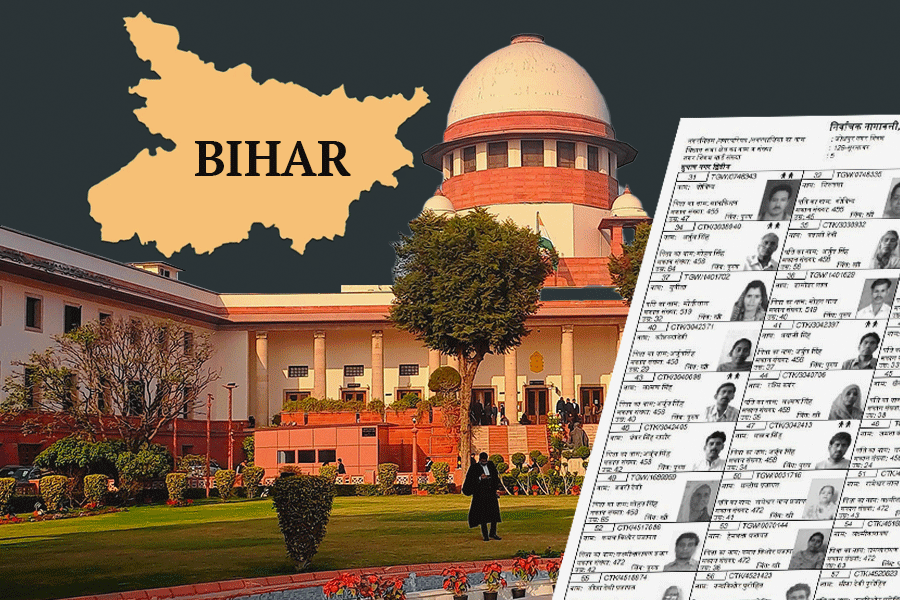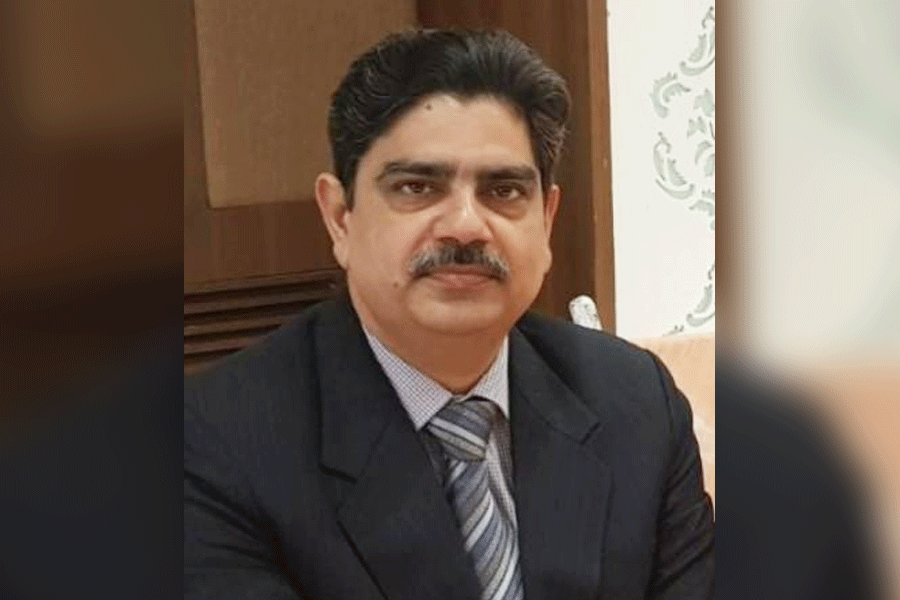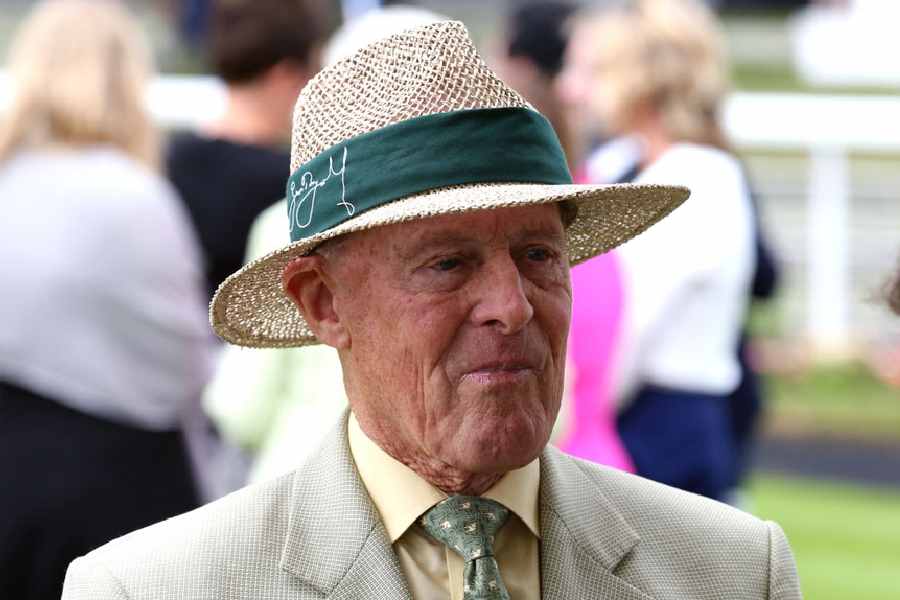 |
I cannot quite remember precisely when I first met Sonali Sen Roy, it could be in 1950 or the next year. I was a young lecturer at the Lucknow University; Sonali was still in Santiniketan, pursuing a course probably at Kala Bhavan. Sonali’s father, a practising physician, had an extensive clientele in Lucknow. He was a man of few words, very British in manners; prim, curt and yet full of understanding and kindness. Many of the Bengali gentry in the employ of the government or the university, who had preferred to settle in Lucknow on retirement built houses in a residential area that had come up not far from the university campus, known as New Hyderabad. Dr Sen Roy was one of the tribe. He had a compact, middle-sized house ideal for indolent living.
The Sen Roys were close relatives of one of my main benefactors in Lucknow, the professor, B.N. Dasgupta, whose son, Parimal — historian-turned-journalist — is one of the few friends from my younger days still surviving. It was, however, not the Dasguptas who introduced me to the Sen Roy family. Basudeo Narayan, an ardent disciple of Jayaprakash Narayan, had gone for further studies to Santiniketan after his release from prison as the Quit India movement petered out; on completing the course at Visva-Bharati, he had come to Lucknow to write a doctoral dissertation in sociology. We were living in the same university hostel and were on most friendly terms. One evening, he mentioned he was going to see his friend from Santiniketan, Sonali Sen Roy, who had come to visit her parents and I might find it interesting to meet her. I accompanied Basudeo. The sitting room in the Sen Roy house was on the first floor. It was elegantly arranged, had comfortable chairs and sofas, and refreshments would arrive at regular interval from the kitchen. Sonali’s elder sister, Hashi, then married to a son of a widely respected Calcutta lawyer well known for his charities and his elegant essays in Bengali on both literary and political themes, was also in Lucknow for a short visit and was present too, the two sisters were a contrast in beauty. Both had classical features, in Sonali’s case perhaps a bit more. But where the elder sister scored was in the natural charm she exuded from her personality; she was more of an extrovert, full of fun and social gossip, and with a joyousness with regard to things happening to her and around her. On the other hand, Sonali’s beauty was enhanced by a quiet, sharp intelligence which got reflected in her eyes; she spoke in measured tones, a reservoir of dignity reigned over her grace and personality.
The four of us had a delightful time stretching over close to three hours. I still remember the exact words Hashi uttered while bidding us goodbye: it had been a long time since they had such a pavitra (pure) adda.
Over the next few months, I met Sonali on a number of occasions either in Lucknow or at Santiniketan; there was exchange of a few letters as well. I soon learnt she had got engaged to Harisadhan Dasgupta, whom too I knew from boisterous sessions at the India Coffee House on Chittaranjan Avenue. He was then quite a rage in Calcutta’s snob circle. He and his elder brother, Kalisadhan, had inherited a large property, including a big house on Southern Avenue which had in the rear a small pond that could pass for a swimming pool. Both brothers were by nature generous hosts and kept open house at their Southern Avenue residence. Aspiring young writers, smart company executives with intellectual pretensions, artists and sculptors, film buffs of different genres, would make a beeline for their house for a morning session; many of them would return in the evening for a spot of Scotch whisky. As far as my remembrance goes, it was Kamal Majumdar who introduced me to the brothers at the Coffee House. Harisadhan had very recently returned from the United States of America. While there, he discovered the advantage of introducing himself as Hary S., he had apparently undergone a course in film production, was engaged for a few months in a film producing corporation as a trainee and returned home with the reputation of a documentary film producer. He did a couple of documentaries for some private as well as public concerns, which were well received. Calcutta intellectuals, otherwise devastatingly cynical, held in reverence whoever was, or claimed to be, foreign-trained. Harisadhan became the talk of the town.
I was immensely pleased at the tiding that two of my acquaintances had decided to be life partners. Sonali remembered to send me the printed letter of invitation to the wedding reception along with a hand-written note requesting my presence. I was at that moment busy making arrangements for my departure for Europe to join the Institute of Social Studies at The Hague and had to miss the event.
Being out of the country for the next few years, I would get only perfunctory news of the newly married couple. They had, I was informed, shifted to Bombay where Harisadhan was not only busy producing documentary films but was also planning to produce a feature film. They had a son and Sonali was trying to get an assignment which would satisfy her urge to do creative work in some branch of fine arts. I did not have any occasion to meet them after my return but Ansu — Parimal — would every now and then respond to my curiosity. For instance, he let me knew in late 1956 that they had a second child, another son.
I think it was February or March the following year that the storm broke; Rusi Karanjia’s Blitz carried a salacious story containing supposedly authoritative details of the liaison between Sonali and Roberto Rossellini. Blitz went as far as to suggest that the whole affair was not only immoral and against the law, but was an affront to Indian patriotism; how come this Italian film director, no matter how celebrated, had enticed an innocent Indian woman; it was like invading India and annexing a piece of our territory. I prefer to believe the account presented in her somewhat haphazardly constructed memoirs by Ingrid Bergman, the outstandingly brilliant Swedish film actress, to whom Rossellini was then married. She and Harisadhan were the direct victims of the adultery committed by their legally recognized partners. But while Ingrid was both angry and bitter with Rossellini, she was careful not to say one word against Sonali. In her view, where pretty-looking women were concerned, Roberto, if I am allowed to borrow Oscar Wilde’s words, was able to resist everything except temptation. Harisadhan met Rossellini soon after his arrival in Bombay with the stated intention of making a film on an Indian theme. His neo-realist Italian pictures were shown in different cities in India, during what was still some sort of novelty in the country, international film festivals, that had bowled over the sophisticated film-goers. Not surprisingly, once he was ensconced in Bombay’s Taj Hotel, there was an unending stream of admiring visitors. Harisadhan introduced himself as a producer of documentary films. Their discussion soon drifted to the problems and possibilities of Rossellini’s proposed picture against an Indian background. When Rossellini mentioned his concern for knowing more about Indian art and culture, Harisadhan’s face lit up: his wife, he told the Italian film director, had spent years at Tagore’s Santiniketan, graduated from there in fine arts and would be happy to offer whatever assistance Rossellini needed. The latter responded by inviting Harisadhan and his wife for dinner over the weekend. The couple arrived. As soon as Harisadhan introduced Sonali to Rossellini, he himself was a forgotten figure. The pre-dinner drinks, the dinner and the post-dinner rituals lasted till midnight. Rossellini said solemnly that he was so impressed by Sonali and the depth of her knowledge that, rather than enlightening him on Indian art, she should help him to prepare the film script and of course the title sheets of the film would explicitly mention her name as principal script writer.
Husband and wife were elated, Harisadhan a shade more than Sonali herself. The recognition of his wife coming from such eminence would, he thought, persuade this or that leading film producer in Bombay to finance the feature film that he had long planned. He deposited Sonali the very next day in Rossellini’s hotel room and took his leave so that she and Rossellini could discuss the structure of the script.
Sonali tried to resist in the beginning, but finally had to submit to Roberto’s magnificent charm. The hours she spent became longer and longer. Poor Harisadhan assumed the script was at its most critical and challenging phase which demanded long hours of labour. Sonali’s increasingly pensive mood and briefness of conversation with him he took as confirmation of his assumption. He did come to hear stray, snide comments from some quarters, but attributed them to envy and worse. His world fell apart when, returning home late one evening, he found a note for him from Sonali; she was sorry, she had love and regard for Harisadhan, but a greater love was beckoning her and she had to say goodbye; she was taking with her the six-month old baby, but the elder son would be there to be nurtured by the father; she hoped Harisadhan would explain to him the situation as gently and tactfully as possible. Harisadhan did not know what to do and spent a restless night. Come morning and it was more horrid: Blitz had not waited one moment to release its sensational scoop. Hell was let loose.
The outrage in the country was all emotion and no reasoning and revealed the ugliest face of a suffocatingly male-dominated society. Newspapers competed with each other to list of Rossellini’s serial debaucheries during his stay in Bombay. Solemn-sounding editorial articles worried over measures called for protecting our women from the predatory eyes of adventure-seeking foreign louts. Questions were raised in Parliament, there was even a suggestion to recall our ambassador in Rome as protest against the incident. The most grotesque demand was for arresting Rossellini and trying him, if possible giving him a life sentence. The more conservative circles did not spare Sonali either, calling her a prostitute and a shame to Indian womanhood.
Fortunately the prime minister, Nehru, kept his cool and objectivity. The fortuitous fact that Indira Gandhi had made her acquaintance with Sonali while she herself had spent a year at Santiniketan helped. Sonali was quietly issued a passport, and well past one midnight Roberto and she, along with the child, flew away in a Europe-bound plane. The storm gradually receded. Rusi Karanjia was happy though that meanwhile the circulation of Blitz had scaled to a much higher stratum than before. It did not take long for Roberto to ditch Sonali and go for another woman. That is however a different story.
A similar furore was sought to be raised by a section of self-appointed social nitpickers when, a few years later, Sonali’s elder sister, Hashi, who had lost her husband a few months previously, decided to re-marry; her choice fell on Tapan Raychaudhuri, the historian. She left her father-in-law’s house to join Tapan. The scandal-mongers could not directly object to her re-marriage; thanks to Ishwar Chandra Vidyasagar’s efforts, it was legally sanctified almost a century ago. Their grouse was based on two hypotheses: (a) she should have waited a while; it was unseemly for a woman to re-marry so soon after the husband’s death; and (b) even though the husband was dead, the father-in-law — the venerable lawyer — was still living, her decision must have shocked and pained him.
I have no idea whether Sonali was aware of it, but she was no trailblazer. A quarter of a century ago before her daring act, a lady reared in Allahabad and married to a member of the teaching faculty of Lucknow University had walked out on her husband with her lover. Nilima Devi, a very bright Bengali girl with multiple talents, was the daughter of a judge in Allahabad High Court. She got married to an economist teaching in the Lucknow University. This gentleman’s approach to life could not be more different from hers; he was frankly a bit of a dull dog. I worked much later as his colleague: he had a good degree from the London School of Economics; but was timid and always had a scared look. Perhaps Nilima Devi’s decision to leave him added to his inferiority complex. Prabhu Guha Thakurta had just arrived with degrees from both London and Harvard. He was a sparkling conversationalist, full of wit and wisdom and with an irresistible way to attract admiration. They got attracted to each other. When Guha Thakurta had arranged a cushy job for himself in Delhi, the couple made up their minds. The two were one day missing in Lucknow and they surfaced in Delhi a couple of days later.
Till now I have referred to three women who revolted against the system, all three happened to be Bengalis. Did this betray my bias? Besides, although each of them was born of Bengali parents, they had spent their lives all along, it would perhaps be pointed out, in either Lucknow or Allahabad; it was supposedly the radical milieu in these two cities which made them the fearless females they became. I plead not guilty. Consider, for instance, the case of Vijaylakshmi Nehru. She was of about the same age as Nilima Devi, who lived very close to Anand Bhavan. Vijaylakshmi, her sister Krishna and Nilima were playmates in their childhood. Around the time Motilal Nehru and his son Jawaharlal were elected president of the Indian National Congress in successive years in the late 1920s, a bright young man from a reputable Muslim family — Syed Hussain — was putting in voluntary work in the foreign office of the All India Congress Committee located in Swaraj Bhavan, which was next door to Anand Bhavan. Vijaylakshmi fell passionately in love with Syed Hussain and was determined to marry him. Motilal Nehru went into a fit; how dare a bounder of a Muslim want to wed a Kashmiri pundit girl, particularly a Nehru girl and she respond affirmatively? He severely upbraided his elder daughter, and was on the point of whipping her. Jawaharlal was more tactful, he took into account the political implications of the entire episode. Syed Hussain was piled with funds, promised a generous remittance every month and persuaded to go over to New York, and never return to India or try to correspond with Vijaylakshmi. Hussain kept his commitment. It is a tribute to his integrity and patriotic fervour that, even in America, he relentlessly campaigned for Indian independence and continued to be a devout believer in the Indian cause even after freedom was achieved. As far as my recollection goes, he was still alive in the late 1940s when Vijaylakshmi arrived as India’s ambassador to the United States. I wonder whether there they ever met and what they told each other.
It did not help Vijaylakshmi to gather the courage to defy the family and marry a Muslim in spite of the radicalism claimed for Allahabad and Lucknow. True, almost at the same time, another Allahabad girl, born of Hindu parents, did dare to wed a Muslim, Aruna Ganguly. She was barely 18 when she married Asaf Ali. She was a Bengali though.
But wait. Shanti Srivashtava, wife of Sadiq Ali, another Congress leader of those days, was very much of Allahabad-Lucknow breeding. There could well be others.
To return to the central issue, there are some organic differences between men and women ordained by nature that cannot be helped. That apart, complete equality between the two sexes must be synonymous with human existence; discrimination against women, whether political, economic or social, on whatever pretext in a system which claims to be democratic must be challenged. I love to think Sonali Dasgupta Rossellini nee Sen Roy, who died earlier this month, was a martyr to that cause.











